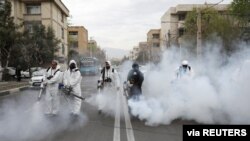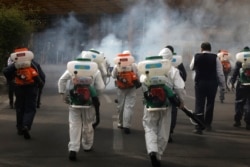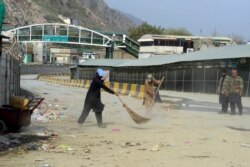Iran’s passive response in battling the coronavirus at home has helped spread the virus in the Middle East, experts say.
Iran, the epicenter of the COVID-19 outbreak in the Middle East, reported the first case in the country February 19 in the shrine city of Qom, nearly 140 kilometers south of the capital, Tehran. As of March 20, the World Health Organization (WHO) reported 19,644 confirmed cases with at least 1,433 deaths.
Iranian officials initially downplayed the spread of the virus as the country was heading into its parliamentary election. This caused a wider spread of the coronavirus, experts said.
“The Iranian regime’s decision to censor information about the spread of the coronavirus in Qom and Tehran in mid-February led directly to the virus spread to countries that people traveled to from Iran, including Lebanon, Iraq, Bahrain, Qatar, Kuwait and likely Turkey and other states,” said Seth Frantzman, director of the Middle East Center for Reporting and Analysis.
People returning from Iran were later among the first to be identified with the virus in countries such as Lebanon, Iraq, Afghanistan, Kuwait and Bahrain.
“This points to a worrisome phenomenon that Iran should have warned those countries, that operate flights or have land borders, about the threat,” Frantzman told VOA.
IRGC’s involvement
As the spread of the virus intensified in the country, Iranian authorities had to take more decisive measures to combat the disease.
Last month, the Iranian heath ministry announced the formation of the “National Coronavirus Combat and Prevention Headquarters.” As part of its mission, this task force has reportedly deployed 30,000 teams supervised by the Islamic Revolutionary Guard Corps (IRGC) to conduct door-to-door coronavirus checks across the country.
Last week, IRGC officials said the agency would play a major role in combating the outbreak.
“All provincial units of IRGC along with medical science universities are in a warlike preparedness mode,” Hossein Salami, IRGC’s chief commander, said during in a video-conference meeting with IRGC commanders.
Around 650,000 of IRGC’s volunteer Basij forces have been disinfecting public places across the country, while thousands of others continue to help medical teams detect the cases, he said.
However, many Iranian activists and health experts have expressed their discontent with IRGC’s handling of the pandemic.
Experts say IRGC’s personnel don’t have the equipment and training needed to combat the virus.
“IRGC efforts in Iran in combating the coronavirus is not deep and fundamental but more of a gesture,” said Alex Vatanka, an Iran expert at the Middle East Institute in Washington.
“They are trying to show the combat at home and satisfy public expectations.”
Beyond borders
The IRGC, which has been involved in military conflicts across the Middle East, Syria, Yemen and Iraq, while maintaining control over groups such as the Lebanese Hezbollah, reportedly continues its activity in the region, despite growing concerns that IRGC officials may carry the virus to other countries.
“The IRGC’s use of clandestine air and land routes to traffic weapons and move militias throughout the region is also a concern regarding the spread of the virus,” said analyst Frantzman, “because the IRGC’s trips are not monitored and often go unchecked by national health authorities in places such as Lebanon, Iraq, Syria and Yemen.”
The Iranian “regime’s negligent response to the virus likely means that infected officials continue to travel around the region and are not tested,” he added.
But Colin Clarke, a senior fellow at the New York-based Soufan Center, says the virus would severely limit IRGC’s activities in the region.
“This is just kind of hitting the pause button for the time being,” Clarke told VOA, adding that “I do not expect the IRGC mission to change.”
Ali Alfoneh, an Iran expert at the Arab Gulf States Institute in Washington, disagrees. He says the pandemic is not likely to impact the IRGC’s operational freedom in Iraq and Syria.
“Since the collapse of the Ba’ath regime in Iraq in 2003, successive Iraqi governments have never been in a position to effectively deny the IRGC operational freedom in Iraqi territory,” he told VOA, adding that the “same applies to the regime in Damascus since 2012.”
On Sunday, the Iranian-backed Syrian government identified its first case of coronavirus.
Local reports, however, say that dozens of people in provinces such as Deir al-Zour and Latakia have already contracted the virus after recent arrivals of IRGC officials in the war-torn country. They allegedly point to a correlation between the rise in new cases and IRGCs activities in the country.
U.N. health officials warn that conflict-ridden countries such as Syria are more prone to the spread of coronavirus because of the lack of medical resources.
Iraq at risk
Iraq, which shares a frontier of about 1,500 kilometers and nine border-crossings with Iran, remains the most porous and vulnerable to the spread of coronavirus.
As of March 22, the total number of coronavirus infections in the country has reached 233 confirmed cases with 20 deaths, according to Iraqi authorities.
The earliest cases of coronavirus in Iraq were reported in late February when a Kirkuk family of four tested positive upon returning from Iran. The Iraqi authorities responded by banning travel to and from several countries, including Iran, with an exception given to diplomatic visits.
Despite the travel ban, flights and ground border-crossings from Iran continued until mid-March with the aim of bringing home thousands of Iraqi nationals such as university students and businesspeople.
According to Ihsan al-Shammari, the head of the Iraq Center for Political Thought in Baghdad, the Iraqi government’s efforts to curb border movement with Iran remain marginal, mainly because of Tehran’s influence on the government of the outgoing Prime Minister Adel Abdul-Mahdi.
“The Abdul-Mahdi government did not respond to any demands by political blocs, elites, and civil society organizations to stop the movement, travel and trade between Iraq and Iran, because Iraq represents an economic lung for Tehran,” said al-Shammari, adding that the Iraqi government’s measures “lacked seriousness” and came late after several cases of the virus were reported across the country.
“Diplomatic and military missions represent a major danger if they transmit this virus. The incident of the Iranian counselor in Najaf may be a clear example of this risk of transmitting the epidemic,” al-Shammari told VOA.
Najaf province’s health department in a statement last Wednesday said that it had diagnosed a family member of the counselor Hamid Mukarm Shirazi with the virus. The statement said Shirazi and his family were to immediately leave Iraq and receive treatment in Iran.
Afghanistan
Sharing a 920-kilometer border with Iran, Afghanistan has reported 34 positive cases of COVID-19 as of March 22. Most of these cases involved those who recently returned from Iran.
Afghanistan has kept its border with Iran open, although main crossings on the border were shut down for two days, February 23-24. Officials say shutting border crossings is not effective because there are many illegal crossing points along the Afghanistan-Iran border.
The U.N. says about 100,000 Afghans have returned to Afghanistan from Iran in the past month. Three million Afghans, including 900,000 refugees, live in Iran.
In addition to thousands of Afghans returning from Iran, the IRGC has been active in the country through its personnel and proxies.
Although their presence increases the risk of spreading coronavirus in Afghanistan, some experts think virus would have an impact on IRGC members and their ability to move around freely.
“Certainly, the IRGC is as vulnerable as any other [organization] when it comes to the threat here so absolutely it would clearly impact them in some way,” Michael Kugelman, an expert on South Asia at the Wilson Center in Washington, told VOA.
Yemen bracing for the worst
Weakened by a five-year conflict and hunger, Yemen doesn’t seem to be ready if coronavirus spreads in the country, U.N. health officials say.
Yemen “is a perfect storm of a disaster should this virus introduce itself,” Altaf Musani, WHO’s Yemen representative, told Reuters recently.
While no confirmed case has been reported in Yemen yet, experts fear the presence of IRGC officials, who support Houthi rebels against government forces, could increase the likelihood of spreading the virus in the country.
If these Iranians “are infected it will likely affect the senior Houthi leadership and military operatives who are close to the Iranians,” said Fatima Abo Alasrar, a Yemen expert at the Middle East Institute in Washington.
VOA’s Nisan Ahmado and Mehdi Jedinia contributed to this report from Washington.






